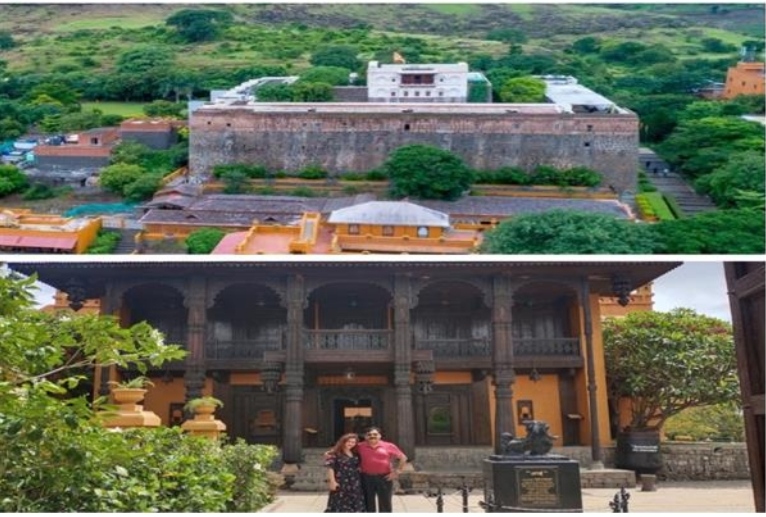Fort Jadhavgarh : An epitome of heritage conservation of Deccan
‘Ladh, jhagad aage badh’—Inscription on main portals of Fort Jadhavgarh

Author Colonel Satish Singh Lalotra
India, the quintessential land of snake charmers, wild elephants, the naked sadhus, and endless sea of humanity jostling for space in minds and physical realm of its populace has always been one step ahead of other nation- states in springing up surprises of all kinds. The people of India, its natural human resource are the prime movers of all their wonderful endeavors to make it happen big on international canvas be it art, medicine, science, culture and heritage presentation to quote a few. This country of ours must be one of those unique nation –states which despite being ruled by a wide array of warring communities like the ‘Huns’, Mongols, Mughals, Afghans to the latest day Brits bounced back to get a grip on itself and script a winning story for the entire world to see. History and its connected adjuncts like heritage are big pathfinders for a country and its populace to do course correction, root for its eminence and set itself on to the trajectory of self-discovery which might have lost its sheen under the constant onslaught of time and tide of events.
Though western state of India, Rajasthan was the harbinger of fortress type of mentality in its inhabitants with the predominant caste of Rajputs ready as ever with their weapons unsheathed wrought by Mughal depredations, the Deccan state of Maharashtra was no less far behind in this aspect. The state of Maharashtra under the aegis of its Guerrilla king ‘Shivaji’ had put a stamp of approval of making impregnable forts /fortresses to thwart the Mughal hegemony in the 17th/18th century. One such fort amongst countless forts dotting the Western Ghats of Sahyadri ranges and has been the star attraction of recent day tourists and catapulted the state on to the stage of national tourism map is the ‘Fort Jadhavgarh”. Nestling atop a hillock and overlooking as a sentinel towards the ‘Dive Ghat’ and further onwards to Pune from the SE direction, the fort was built in the year 1710 by the great Maratha General Pilaji Jadhav Rao in the army of ‘Chattarpati Sahuji maharaj’ the grandson of Chattarpati shivaji maharaj.
Self, wife and daughter taking advantage of the weekend break drove up all the way to the Hadapsar- Saswad road towards Jadhavwadi a distance of about 22 kilometers from Pune to have a look/see of one of the most well-kept forts of Maratha empire now converted to a 5 Star hotel under the aegis of ‘Kamat group’ of hotels. This place was a residence as well as an extremely secure area when under threat by the enemy armies. The fort has all the characteristics of Maratha craftsmanship and has quite a few architectural similarities to other Maratha forts such as the ‘Singhad fort’. Spread over 25 acres of undulating terrain, Fort Jadhavgarh has a very unique motto inscribed on its massive portals —‘Ladh, Jhagadh, aagebadh (Fight and move forward) which epitomizes the core thinking of the Maratha army poised at that point of historical cusp of its doing. Practiced for over 300 years of its tumultuous existence, the Marathas lived by this motto to its entirety.This one liner encapsulates a world in itself even today i.e. one has to continuously fight and move forward to attain one’s goals in life. As we entered the massive fort gate it took us some time to sink in the feeling of its grandeur spread all over. Walking up the massive stone laid stairways is quite an ordeal for the elderly due to the stairs being spaced inter se quite far. What awaits a tourist are the strong fortress walls, secret passageways, dungeons, lush green lawns, cannon and gun holes /emplacements, escape routes etc all etched in a glory of bygone era reeking of valour and royalty galore.
The icing on the cake is that this fort has been taken under the wings of ‘Kamat group of Hotels’. The chairman of Kamat hotels, MrVithal Kamat has in fact been a pathfinder for heritage conservation of forts in Maharashtra which unlike Rajasthan doesn’t have the legacy of heritage conservation on a grand scale. Be that as it may, Fort Jadhavgarh is the first hotel –cum –fort to have seen a change in its fortunes since most other heritage hotels are either Havelis or palaces. A first time visitor to the fort is simply mesmerized by the painstaking efforts which Kamat group has undertaken to bring about a harmonious balance of modern amenities without changing the basic structure of the fort. The Marathas in fact during those times led a very Spartan and rugged life which is all too visible all around the fort.Even within fort precincts, natural resources such as the pond with its perennial flow of water was guarded zealously to tide over any siege thrown by the Mughals leaving the trees all around the pond intact as camouflage and concealment.
Before the fort was give on lease to the Kamat group of hotels, the two descendants of General Pilaji Jadhav i.e. Anna sahib and Dada sahib resided with in the fort premises. As the trio of us climbed the massive stone stairs and entered the fort’s spiked Deori (gate) we were greeted by the ‘Mavalas’(soldiers during the times of Shivaji) who play the ‘Turturi’ and a lady dressed in the traditional ‘Nauvari”(a 9 yard sari). Incidentally fort Jadhavgarh still retains its historical lexicon in naming its hotel staff to give a feel of Maratha royalty to its tourists /visitors. The names of the hotel general manager and staff at the reception are known as ‘Kiledar’ and ‘Swagatkakshya’. Whereas that of the swimming pool goes by the name of ‘Kund’, coffee shop area as ‘Chajja’, the rooms as ‘Kholi’, Akhada for the health conscious and so on. Payatha –the ethnic foothill restaurant at the fort, Aangan –the outdoor courtyard café offers a delicious array of cuisines amidst the lush green Sahaydri Mountains.
A museum, displaying various historically important artifacts is conveniently located inside the fort precincts for a historical, tour. The audio tour of the fort is the ultimate USP of this unique place which enables an avid traveller to instantly relate with the fort’s vitals. The audio-video tour has been planned in a very unique way with 27 points of historical interest abounding the fort premises. Eight points of historical value are situated within the fort with rest spread all around the area. Each point has been numbered in a sequential manner. The reception area provides a tourist with the headphones and a listening device with prerecorded version of the point of interest leaving a guest spell bound.
In addition the fort has provision for Rifleshooting, archeryand lot of other wonders awaiting you to try your hand at. An avid trekker can don his shoes and be ready at the main fort gates for an early morning ‘Moheem Trek’ guided by the fort trekker guide an ex-serviceman Mr Talekar of Maratha light infantry. Mr Talekar will take the tourists on a 10 kms of trek spanning the 25 square kilometers area of the fort property covering all the vantage points of Sahaydri Mountains surrounding the fort with excellent views of Purandar fort and Malhargarhfort. The trek also throws wild life surprises in the form of deers, foxes and rabbits hopping around the table top mountains. Mr Kamath has done well to renovate the swimming pool inside the fort which a tourist can take advantage of by indulging in some quick splashes time permitting. The spa in the fort premises is a great draw amongst the much tired and fatigued urbanites who feel rejuvenated once having tasted its qualities. To tease the taste buds of the touring guests the fort has conveniently placed best of chefs and assorted things in place at its restaurant ‘Paytha’ and ‘Chajja’ which has a wide range of menu to offer and choose from starting from traditional Indian delicacies to continental. On week end days the fort arranges musicians of repute from Pune to come all the way to ‘Fort Jadhavgarh’ and perform to the tourists in a relaxed ambience at these restaurants.
Fort Jadhavgarh has few unique features about itself which are not found elsewhere. The famous ‘Ayeimahal and museum’, the 300 years old Hanuman temple and the pond dug up as a result of building the fort are something which a discerning tourist will find interesting. The famous Ayeimahal is dedicated to the mother of Mr Vithal Kamath who very painstakingly has collected 35000 pieces of artifacts detailing every aspect of rural India in its finery. Out of these artifacts a major part is kept in the Orchid hotel at Ville parle, Mumbai with rest over here at the fort. Overlooking the dug up pond is again a 300 years old banyan tree whose roots go all the way down into the earth symbolizing the sustainability of mother earth. The fort also doubles up as a popular ‘Destination wedding’ for the mobile and upward moving urban elite. With a huge numbers of rooms/suites totaling 220, the fort is a veritable hub of tourists of all kinds. As a throwback to the old Maratha times, the fort organizes every day the opening and closing ceremony of the massive gates at 9.30 am and 6.30 pm for a short duration with the fort sentries coming to attention and the in charge of fort sentries narrating the importance of this opening and closing ceremony of the gates.
It took the trio of us a whirlwind tour of about 48 hours on our toes to get a semblance of what the fort stood for in the bygone era. Since my wife is a history teacher in the school it was like a ‘Déjà vu’ for her to come to the fort and explore all its specialties. All said and done it went to the fate of Mr Vithal Kamath and his group of hotels to reinvigorate the moribund fort of Jadhavgarh and bring back its lost sheen for the entire world to watch. I hope this model is followed country wide.




